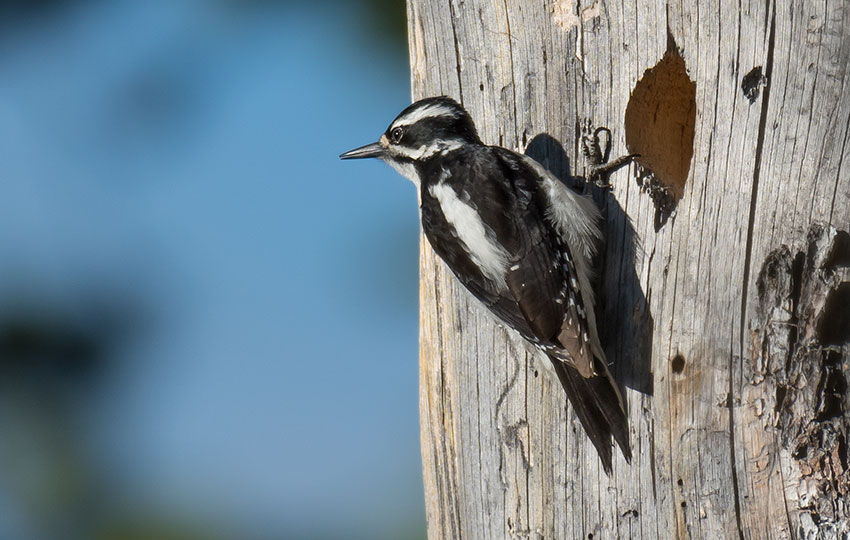
For many people, woodpeckers conjure up imagery ranging from the annoying. Those pesky birds that perforate the sides of homes new and old. To the absurd. Woody Woodpecker up to his usual hijinks. To the industrious. Woodpeckers are considered by many as the lumberjacks of the bird world, after all.
There’s no question that they can be all of those things.
During the spring of 2020, near my home in South Lake Tahoe, a White-headed Woodpecker turned one of the walls of my neighbor’s second home into Swiss cheese.
Support Tahoe Trail Guide with a financial contribution via PayPal (single contribution) or Patreon (reoccurring contributions). Your support of Tahoe Trail Guide is very much appreciated!

I’ve watched a Pileated Woodpecker rear back its head while belting out a maniacal laugh. This just before flying off as if it were a physical incarnation of the cartoon character.
And, countless species have claimed the vacant tree cavities created by woodpeckers as their home.
Based on the aforementioned examples, it probably seems like woodpeckers are easy to label or characterize. However, their natural tendencies and actions are quite profound. And, they contribute to the overall health of forests.
I wrote this article for my 2020 California Naturalist Certification Course capstone project. I’ve since edited and expanded the text. Additionally, I separated it into two articles. This is the first article, an overview of woodpeckers and how they contribute to healthy forests. The second article provides an overview of the 12 woodpecker species of the Lake Tahoe Basin.
The following video is my capstone project with the original elements intact.
3 Roles that Woodpeckers Play in Maintaining a Healthy Forest
The three primary ways in which woodpeckers help to maintain healthy forests are:
- They provide nesting cavities for many species of wildlife.
- They’re a check on the insect population.
- They help to accelerate the decomposition of dead and dying trees.
1) Woodpeckers Provide Nesting Cavities for Many Species of Wildlife
Woodpeckers are primary cavity nesters. This means they excavate from scratch new homes in which to live. This is a critical service to the local fauna population.
Many species of birds and other wildlife are considered secondary nesters. They take up residence in the cavities left by woodpeckers.
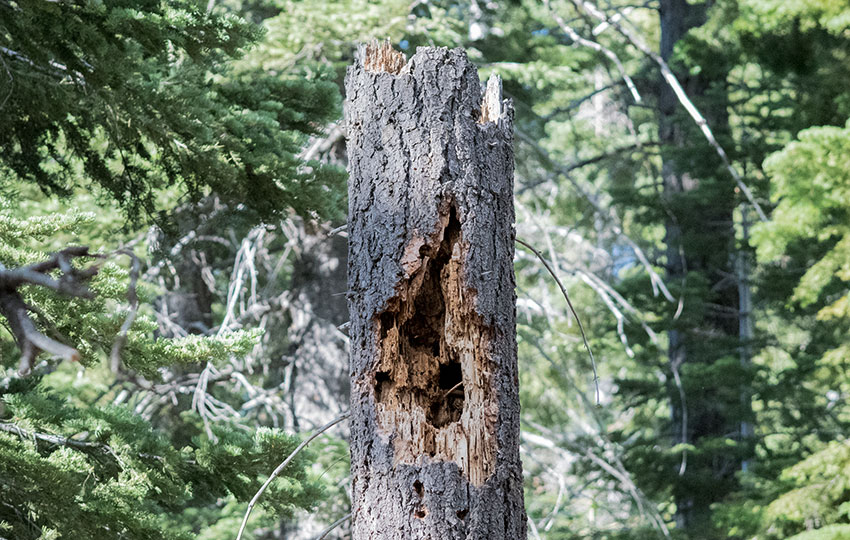
According to an article about woodpeckers published in the summer 2017 edition of the Western Arborist…
“About forty of the sixty other cavity nesting birds in North America nest in the abandoned homes of woodpeckers.”
Keep in mind that woodpeckers aren’t just building homes for other critters because they’re generous. Most cavities left behind are simply the result of woodpeckers foraging for their next meal.
There’s a variety of woodpeckers at Lake Tahoe. So, there’s an abundance of various sized tree cavities in which to support many species.
One thing I find interesting is that woodpeckers don’t just chisel their nests from the outside. Once they’ve burrowed far enough into a tree, they continue their operation from inside.
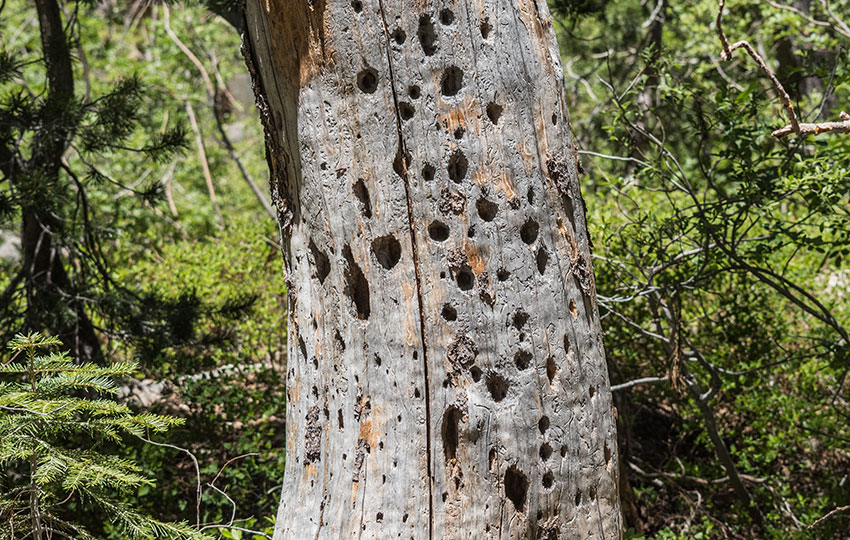
Remember that White-headed Woodpecker that built itself a home inside my neighbor’s wall? I’ve heard it spend hours pecking away from the inside of the house’s wall.
I’ve also heard a Hairy Woodpecker drilling from the inside of an old branch-less, yet still upright, snag.
In both cases, I spent quite a long time trying to pinpoint the location of the woodpecker. The challenge came from the sound being so muffled and indirect.
2) Woodpeckers are a Check on the Insect Population
Much of a bird’s day involves searching for food. Woodpeckers are no different in this respect. It’s estimated that woodpeckers can consume thousands of insects a day. Also, the way in which woodpeckers seek food yields benefits to other species.
Some woodpeckers prefer to work on live trees. Others gravitate toward dead ones due to the high concentration of insects that reside within them.
Regardless, when woodpeckers hammer away at a tree it’s usually because they’re searching for food such as larvae and wood-boring insects.
For example, you may find a Pileated Woodpecker chiseling away at a rotten log on the forest floor in search of Carpenter Ants (one of their favorite foods).
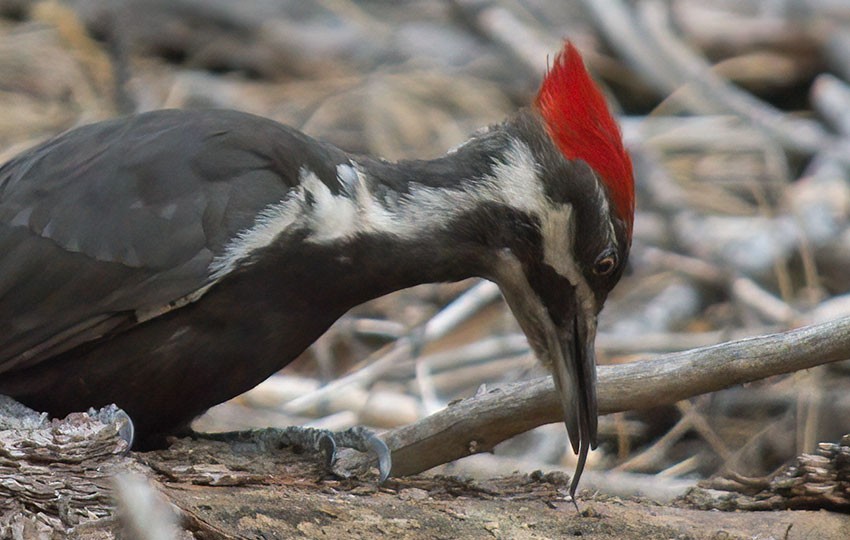
As I previously mentioned, the cavities left behind by woodpeckers provide homes for other wildlife. And many of the species who inhabit those cavities also happen to be insectivores. Additionally, the exposed sections of the trees a woodpecker excavates provide access for other insectivores to probe for food.
Red-breasted Sapsuckers, for example, will systematically peck at live trees. They do this in order to cause them to yield sap. They’ll then leave the site while the sap begins to collect. During that time, other wildlife will consume the fresh sap along with insects that become trapped in it. When the sapsuckers return, they’ll continue to feed on the flowing sap and the trapped insects.
Without woodpeckers and other insectivores, the world would most likely be overrun by the insect population.
3) Woodpeckers Help to Accelerate the Decomposition of Dead and Dying Trees
Half of a tree’s worth with regard to forest health comes with its death. For example, all of the nutrients it gives back to the earth. So, we can thank woodpeckers for accelerating its rate of decomposition.
The insects for which a woodpecker searches definitely contribute to the breakdown of trees.
However, it’s at a very slow rate. But the violent mechanical action of a woodpecker chipping, chiseling, and hammering away at a tree is quite rapid. And, the demolition process sends fragments of the tree flying in all directions. This helps to disperse the nutrients in which that dying tree provides across the forest floor.
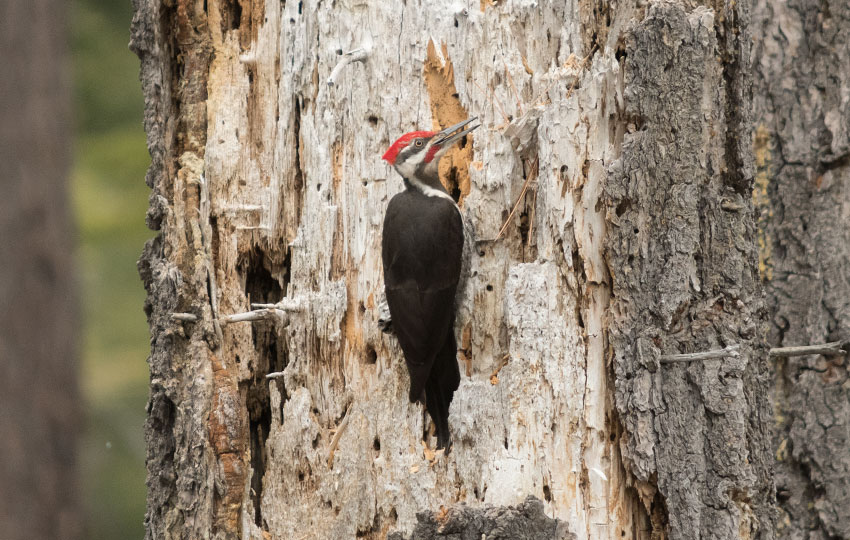
Unique Aspects of Woodpeckers
Woodpeckers are a unique breed of bird and worthy of continued study. So, as I learn more about them, I’ll continue to add to this list relevant information.
Woodpeckers use drumming as a means of communication instead of traditional birdsong.
The rapid-fire drumming is probably the sound most associated with woodpeckers. And it’s a method by which woodpeckers establish their territory and attract a mate.
Drumming is not actually considered damaging to a tree, however. It’s accomplished using less force. Probably more akin to a boxer’s jab than a big right cross.
Watch the video clip of the White-headed Woodpecker at the beginning of my capstone project. To me, it sounds like it’s having a conversation with another woodpecker in the distance. There’s a mating couple of White-headed Woodpeckers in the same location in which I recorded this woodpecker drumming. So, I believe the two of them are simply having a conversation while they’re getting ready for the day.
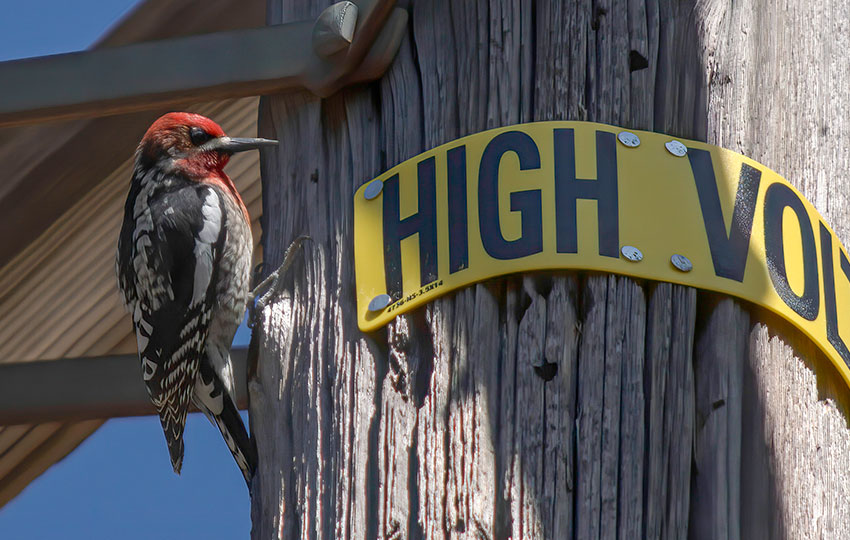
Woodpeckers’ brains aren’t adversely affected by their work for multiple reasons.
Woodpeckers have been a point of interest for scientists who study the effects of brain trauma. In particular, many have studied them with regard to impacts to the head. Research has discovered that:
- The orientation of a woodpecker’s brain is perpendicular to the force of impact. This minimizes the effects of brain movement.
- A woodpecker’s skull contains less fluid and their brain occupies more space in the skull. This decreases the amount of “sloshing” around their brain may experience.
- Woodpeckers push their lower beak slightly forward (of the upper half) right before the point of impact. This enables their body (of which the lower beak is connected) to absorb most of the impact.
- Woodpeckers’ beaks features a harder outer surface and a softer inner core. This minimizes impact and vibration, and is similar to a bicycle helmet design.
- While pecking, a woodpecker retracts its exceptionally long tongue and wraps it around its skull. This acts as a vibration dampening system for their brains.
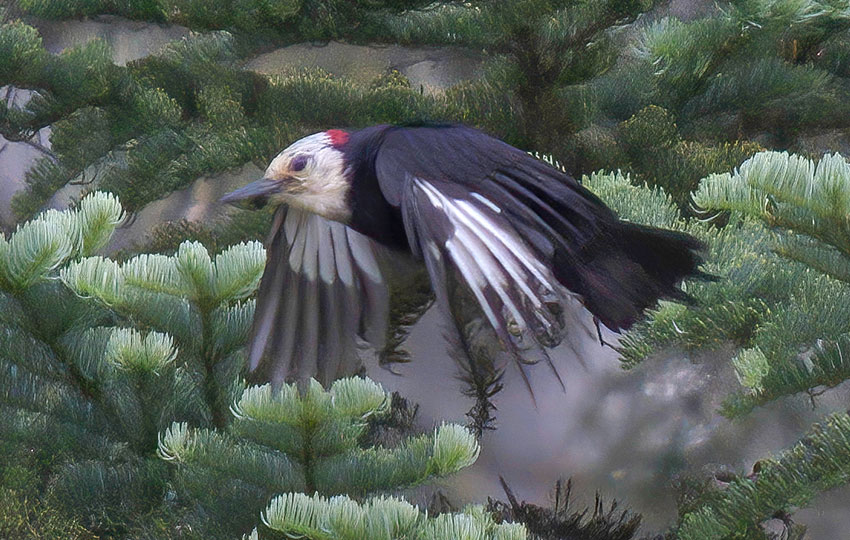
More Fun Facts about Woodpeckers
Woodpeckers have exceptionally strong toes in which to cling to the sides of trees, but only in an upright position.
Woodpeckers don’t have the correct anatomy to climb down trees face forward like Nuthatches, for example. Instead, they hop and walk backwards down trees.
The tail feathers of woodpeckers are stiff so they can use them as a prop or kickstand. In combination with their strong toes, woodpeckers position their bodies away from the tree during excavation. This provides them leverage while working and keeps their bodies off of the tree. The last part is important because it prevents them from experiencing the vibrations (through the tree) that they’re creating.
Generally, woodpeckers prefer an open forest that lacks a robust understory so that they can work while maintaining a watchful eye for predators.
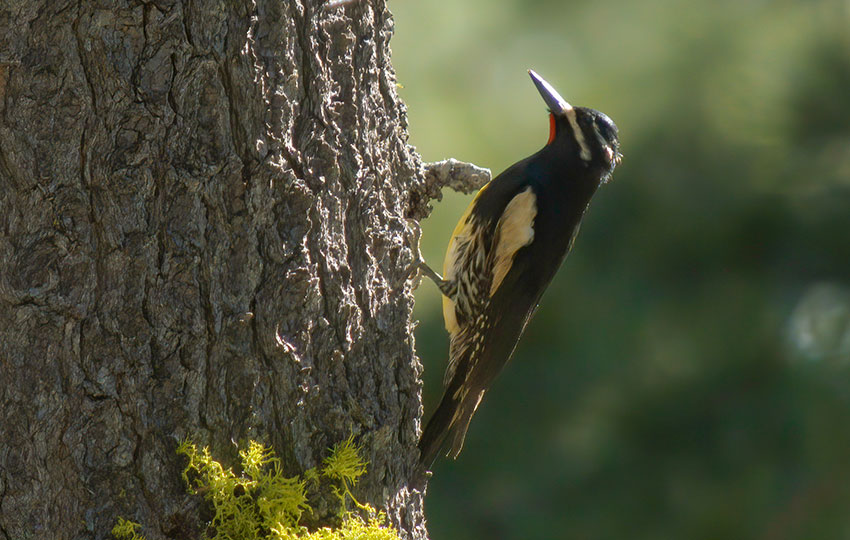
Disclaimer
To be clear, I’m not an ornithologist so I’m sure there are many details about woodpeckers I’ve left out. There are most likely some minor inaccuracies in this article as well. Just know that I produced this project in good faith and to the best of my current abilities and knowledge.
I’m constantly updating articles on Tahoe Trail Guide in an effort to keep them as accurate and up-to-date as possible. So, post any feedback or corrections in the comment section below.
Articles About Lake Tahoe Plants and Wildlife
The following Tahoe Trail Guide articles feature information, history, and stories about the various forms of plant and wildlife that you can find at Lake Tahoe.
Lake Tahoe Wildflowers
- Two Major Factors that Determine Peak Bloom Times for Wildflowers at Tahoe
- Tips for Finding Wildflowers at Tahoe
- The Sinister Mustard Flower Rust
- Big Yellow Wildflowers with Big Green Leaves called Woolly Mule’s Ears and Arrowleaf Balsamroot
Trees of the Sierra Nevada
Birds of Lake Tahoe
- The Tree Cleaving Pileated Woodpecker
- How Woodpecker Contribute to Healthy Forests at Lake Tahoe (and other fun facts)
Fish of the Sierra Nevada
Creating an Immersive Outdoor Experience
- Cultivating Adventure in Your Daily Life
- Deepen Your Outdoor Experience by Documenting Your Nature-Related Observations
- Considerations and Reasons for Doing a Big Year
Whenever you’re at Lake Tahoe and take photographs of the birds you see,
post them on Instagram using the hashtag Birds of Lake Tahoe.
I’d love to see what you’re finding out there 🙂
I am so happy I found your blog and I absolutely love your information about how woodpeckers contribute to healthy forests at lake tahoe and other fun facts about woodpeckers! I liked and it is wonderful to know about so many things that are useful for all of us! Thanks a lot for this amazing blog!!
Thanks so much for the kind words 🙂
And, glad you found my information about woodpeckers at Lake Tahoe interesting!
Thank you for sharing about how woodpeckers contribute to healthy forests at lake tahoe and-other fun facts about woodpeckers with us, these will be really helpful to many.. I love reading this blog; it talks so much about planning a great idea about it. Keep sharing such informative articles in future, will be appreciated.
Thanks so much for the feedback. I’m glad you enjoyed the article 🙂
Congratulations on completing your California Naturalist Certificate class! Your capstone project is great – I love hearing the sounds of woodpeckers bouncing around the forests of Tahoe. I’ve looked into the Certification class but since I live in San Diego and with CoViD restrictions, it’s nice now to spend my free time outside without committing to more inside study.
Hey Kathleen,
Thanks so much for the kind words. Glad you enjoyed the presentation 🙂
The course was great, and I highly recommend it. I was already enrolled in it before Covid hit, so they kept the program alive. However, we turned in our work and did our classroom discussions through an online portal. Then, all of our field work was performed on our own outside. In many ways the format worked fine for me because I live in South Tahoe and have easy access to the outdoors (for observations, etc.). But overall, I would’ve preferred a more traditional classroom experience. That said, Lake Tahoe Community College did a great job of ensuring that we’d all have a class to attend. And, because it was online, there were a number of people taking it from around the state.
Anyway, get your cert one of these days! And, keep in touch. Take care!